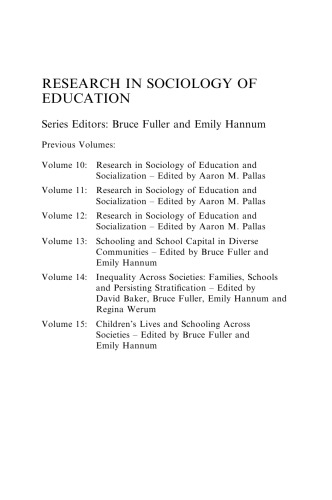

Most ebook files are in PDF format, so you can easily read them using various software such as Foxit Reader or directly on the Google Chrome browser.
Some ebook files are released by publishers in other formats such as .awz, .mobi, .epub, .fb2, etc. You may need to install specific software to read these formats on mobile/PC, such as Calibre.
Please read the tutorial at this link: https://ebookbell.com/faq
We offer FREE conversion to the popular formats you request; however, this may take some time. Therefore, right after payment, please email us, and we will try to provide the service as quickly as possible.
For some exceptional file formats or broken links (if any), please refrain from opening any disputes. Instead, email us first, and we will try to assist within a maximum of 6 hours.
EbookBell Team

4.4
22 reviews
ISBN 10: 1846639107
ISBN 13: 9781846639104
Author: Bruce Fuller
Civic leaders around the globe now press educators to raise the performance of students and schools. Backed by a colorful array of odd bedfellows - from corporate interests to advocates for the poor - politicians seek to narrow the aims of learning, advance routine curricular packages, and tightly align standardized tests. Why are governments pushing to centrally regulate teaching and learning at this historical moment? Do these accountability mechanisms succeed in boosting student achievement? How are teachers responding to top-down rules, incentives, and the recasting of what knowledge counts inside school? These are the hotly contested ideological and empirical questions asked by this volume's contributors, a rich mix of sociologists, applied anthropologists, and education researchers. As public schools struggle to regain public confidence, political actors eagerly try to look strong and forceful. But do centralized accountability policies lift the motivation of teachers and students? Or, is this reform strategy a brilliant political remedy - but one that makes little difference inside the classroom.
Chapter 1. Overview: Liberal learning in centralizing states
The political imperative of performance
Centralizing rules to spark local motivation?
Taking stock: The dilemmas and local effects of accountability
Teachers and principals respond: Organization of the book
Acknowledgments
References
Chapter 2. Accountability and teaching practices: School-level actions and teacher responses
Background
Research questions
Data and methods
Results
Discussion
Notes
References
Chpater 3. District leaders eroding school coherencequest The interpretation of accountability manda
Introduction
Theoretical framework
Research questions
Data and methods
Results
Discussion
Notes
Acknowledgements
References
Chapter 4. Tightening the ship or slowly sinkingquest Reshaping teachers’ work conditions
School structure and the aims of accountability
Accountability policy and teachers’ working conditions
Survey data analysis: Teachers’ time and professional empowerment
Qualitative Analysis: Teachers’ Experiences - Time and Empowerment Intertwined
Discussion
Notes
Acknowledgments
References
Chpater 5. Raising achievement or closing gapsquest Identifying effective accountability tools
Dissecting effective schools
Study design - identifying effective accountability tools
Discussion and policy implications
Notes
Acknowledgments
References
Chapter 6. High stakes diplomas: Organizational responses to California’s high school exit exam
Introduction
Background and history of exit exams
Underlying policy assumptions of exit exams
Existing research
Methods and research questions
Organizational and Instructional Responses: Limited Support, Narrowing the Curriculum
Instructional change: Narrowed curriculum for the lowest achieving students
Notes
Acknowledgments
References
Appendix
Appendix. (Continued•)
Chapter 7. District capacity and accountability: professional development as reform tool
Theoretical grounding
Methods
Findings
Discussion
Notes
References
Chapter 8. Exit exams and organizational change in a vocational high school
Introduction
Case study school
Theoretical tools
Methodology
Case study
One school’s story
A focus on academic achievement
Restructuring teaching time
Curricular tensions, but apparent success
Eroding students’ work experience
Working against parallel reforms
State support and resources
Selectivity
Students’ views
Persisting inequalities
Discussion - the dilemmas of high stakes testing
Notes
Acknowledgments
strong states, weak schools
states with worst school systems
strong state vs weak state
weak schools
a stronger nation through higher education
Tags: Bruce Fuller, Strong States, Dilemmas